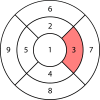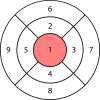Association between hydroxychloroquine intake and damage to the outer nuclear layer in eyes without manifest retinal toxicity
- PMID: 39334015
- PMCID: PMC11429237
- DOI: 10.1186/s12886-024-03684-3
Association between hydroxychloroquine intake and damage to the outer nuclear layer in eyes without manifest retinal toxicity
Abstract
Background: Hydroxychloroquine (HCQ) is widely used to treat various autoimmune diseases but carries a risk of retinal toxicity, particularly with prolonged use. Despite advancements, uncertainty persists regarding optimal screening methods. Recent advances in OCT have enabled early detection of retinal damage, with studies suggesting that thinning of specific retinal layers may be an early indicator of toxicity. However, there is a gap in research on outer nuclear layer (ONL) thinning in HCQ users without apparent retinal toxicity. This information is crucial for improving screening and identifying the ONL as a reliable biomarker for screening. Therefore, this study aimed to investigate the association between HCQ intake and ONL damage in eyes without manifest retinal toxicity.
Methods: A case‒control study was conducted at the ophthalmology department of Eye and Ear Hospital International from July 2022 to June 2023. The study included 20 individuals on HCQ and 20 age-matched controls. The data were obtained through chart reviews, and participants underwent comprehensive ophthalmic assessments.
Results: A total of 80 eyes were analyzed. Patients on HCQ exhibited significantly thinner perifoveal, parafoveal, and overall ONL compared to controls (P < .001, P < .012, and P < .004, respectively). Similarly, this association was found in the nasal, inferior, and temporal quadrants of both the inner (region 3: P < .01, region 4: P < .001, and region 5: P < .03) and outer zones (region 7: P < .04, region 8: P < .001, region 9: P < .02), most pronounced in the inferior regions. The cumulative dose was weakly associated with decreased ONL thickness only in the nasal quadrant of the inner zone (region 3: P < .047). Correlation analysis of the initial and most recent OCT scans in the same individuals revealed a weak association with ONL thinning in the central zone (region 1: P < .0048).
Conclusion: The thickness of the ONL can significantly decrease in patients taking HCQ, even in the absence of of manifest retinal toxicity. This study is the first to evaluate this association in eyes with negative screening and diagnostic tests for HCQ retinopathy. The findings suggest that ONL thickness could serve as an early diagnostic indicator for HCQ retinal toxicity.
Keywords: Autoimmune diseases; Early detection of retinopathy; Hydroxychloroquine; Outer nuclear layer thinning.
© 2024. The Author(s).
Conflict of interest statement
The authors declare no competing interests.
Figures





Similar articles
-
Quantitative assessment of outer retinal layers and ellipsoid zone mapping in hydroxychloroquine retinopathy.Br J Ophthalmol. 2019 Jan;103(1):3-7. doi: 10.1136/bjophthalmol-2018-312363. Epub 2018 Sep 6. Br J Ophthalmol. 2019. PMID: 30190364 Free PMC article.
-
Impact of Structural Changes on Multifocal Electroretinography in Patients With Use of Hydroxychloroquine.Invest Ophthalmol Vis Sci. 2021 Sep 2;62(12):28. doi: 10.1167/iovs.62.12.28. Invest Ophthalmol Vis Sci. 2021. PMID: 34581725 Free PMC article.
-
VOLUMETRIC SINGLE-LAYER INNER RETINAL ANALYSIS IN PATIENTS WITH HYDROXYCHLOROQUINE TOXICITY.Retina. 2016 Oct;36(10):1941-50. doi: 10.1097/IAE.0000000000001036. Retina. 2016. PMID: 27258672
-
Mimickers of hydroxychloroquine retinal toxicity.Clin Exp Ophthalmol. 2024 Dec;52(9):1003-1015. doi: 10.1111/ceo.14461. Epub 2024 Dec 3. Clin Exp Ophthalmol. 2024. PMID: 39626654 Free PMC article. Review.
-
Evaluation of changes in thickness of macular sublayers in patients using Hydroxychloroquine: a cross sectional case-control study and literature review.Cutan Ocul Toxicol. 2025 Mar;44(1):55-62. doi: 10.1080/15569527.2024.2438629. Epub 2024 Dec 16. Cutan Ocul Toxicol. 2025. PMID: 39680032 Review.
References
-
- Marmor MF, Kellner U, Lai TYY, Melles RB, Mieler WF, Lum F. Recommendations on screening for Chloroquine and Hydroxychloroquine Retinopathy (2016 revision). Ophthalmology. 2016;123(6):1386–94. 10.1016/j.ophtha.2016.01.058. - PubMed
-
- Melles RB, Marmor MF, Permanente K, Corresponding M. The risk of toxic retinopathy in patients on long-term hydroxychloroquine therapy. JAMA Ophthalmol. 2014;132(12):1453–60. 10.1001/JAMAOPHTHALMOL.2014.3459. - PubMed
-
- Tsang AC, Ahmadi S, Hamilton J, et al. The Diagnostic Utility of Multifocal Electroretinography in detecting chloroquine and hydroxychloroquine retinal toxicity. Am J Ophthalmol. 2019;206:132–9. 10.1016/j.ajo.2019.04.025. - PubMed
-
- Jorge A, Ung C, Young LH, Melles RB, Choi HK. Hydroxychloroquine retinopathy — implications of research advances for rheumatology care. Nat Rev Rheumatol. 2018;14(12):693–703. 10.1038/s41584-018-0111-8. - PubMed
-
- Marmor MF, Hu J. Effect of Disease Stage on Progression of Hydroxychloroquine Retinopathy. JAMA Ophthalmol. 2014;132(9):1105–12. 10.1001/JAMAOPHTHALMOL.2014.1099. - PubMed
MeSH terms
Substances
LinkOut - more resources
Full Text Sources
Miscellaneous

